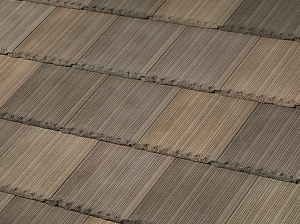When high-profile tile (rise to width ratio of 1:5) or raised/counter battens are used with any profile in conjunction with other non-roof related details, a less prescriptive installation method can be used. Installation of ASV systems is made simple with one-step batten systems offered by some manufacturers. These products eliminate the need for vertical battens. Many local public utilities and municipalities offer rebates for “cool roofs” and energy-efficient roofing systems. A good source for information about rebates is the Database of State Incentives for Renewables & Efficiency.
In cold and snowy climates, counter batten systems and snow guards can reduce damage from ice dams and snow movement on tile roofing, minimizing maintenance and repair costs.

Installation of above-sheathing ventilation, or ASV, systems is made simple with one-step batten systems, like Boral Roofing Products’ Elevated Batten System and Eagle Roofing’s Scalloped Battens. After tile roofing is installed, ASV is invisible.
Ensuring the maximum life for a roof means dealing with regional environmental challenges. Intense UV, high winds and hail can wreak havoc on roofing. The naturally sourced materials in clay and concrete tiles are resistant to degradation from UV. Proper fastening reduces the chance of wind damage. In high-wind areas, there are alternative fastening methods, including straps, clips and foam adhesive, that can provide substantial uplift resistance. With Class 3 (1 3/4-inch ice balls) and Class 4 (2-inch ice balls) hail-impact resistance ratings, tile roofs may qualify homes for a reduction in homeowners’ insurance in hail regions.
When considering reroofing with tile on an existing home with metal or asphalt shingles, local ordinances may require permits. Many building codes allow two to three layers of asphalt shingles, which results in a weight comparable to that of a tile roof. While basic framing typically supports the weight of a tile roof, rafter and truss systems vary. An engineer should be consulted to verify the structural sup- port is adequate. If structural reinforcement is needed, additional bracing procedures are often simple and can be done quickly.
3. LONG-TERM VALUE/LIFE-CYCLE COST
Life-cycle costs are the total cost per square divided by the number of years of expected life of the roof. The expected life of a tile roof (50-plus years) gives it a strong advantage in a cost per square per year comparison. Every home, every roof type and every region of the country has variables in labor and material costs that make life-cycle costs challenging to pinpoint.
Let’s look at it using a residential roofing contractor’s typical customer. Based on a 2013 study by the Washington, D.C.-based National Association of Home Builders, the average homebuyer stays in his or her home for 13 years before moving out. Our hypothetical customer is in the process of purchasing a home when the home inspection reveals it is time to reroof. After negotiating a reduced sale price to compensate for the new roof, the new homeowner chooses an energy-efficient tile with a regionally appropriate installation, understanding the new roof will provide decades of worry-free protection from the elements. The installation complies with local energy requirements, giving the new owner 13 years of energy savings and possibly rebates or credits from the local public utility. If the home is in a hail-prone area and a Class 4 hail-impact-resistant tile is selected, the homeowner may receive discounts on his or her home insurance related to the hail- and fire-resistant nature of the tile.
Thirteen years of energy savings and insurance benefits later, as well as a couple hail claim deductibles avoided (that his or her neighbors had to pay), our “average” homeowner puts the home on the market. It will have the same beautiful tile roof, virtually unchanged, since the day it was installed. The roof will enhance the curb appeal and the sale price of the home.
Thirteen years ago, the homeowner asked his or her trusted contractor “How much will it cost?”, and the contractor helped the homeowner make a wise investment. The outcome would be different if that contractor had recommended a bare-bones, no-profit proposal for the cheapest material available. The homeowner’s realtor would be recommending that the roof be replaced before listing and showing. Buyers’ inspectors would caution their customers about reasonable expected roof life. And buyers would factor that into their offer. Additional “Resources” are available below to help you make the quality presentation to your next homeowner who needs a new roof.
PHOTOS: Boral Roofing Products
RESOURCES
There are resources available to help roofing contractors make a presentation for quality of tile roofs.
Boral Roofing Products’ “Reroof With Tile” Brochure
“Steep Slope Assembly Testing of Clay and Concrete Tile Roofs”, by Dr. William Miller, Ph.D., P.E.





Be the first to comment on "Help Homeowners Understand the Quality Proposition of a Tile Roof"